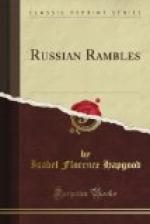In the olden times, the beautifully colored and ornamented tile stoves were built with a “stove bench,” also of tiles, near the floor, on which people could sleep. Nowadays, only peasants sleep on the stove, and they literally sleep on top of the huge, mud-plastered stone oven, close to the ceiling. In dwellings other than peasant huts, what is known as the “German stove” is in use. Each stove is built through the wall to heat two rooms, or a room and corridor. The yard porter brings up ten or twelve birch logs, of moderate girth, peels off a little bark to use as kindling, and in ten minutes there is a roaring fire. The door is left open, and the two draught covers from the flues—which resemble the covers of a range in shape and size—are taken out until the wood is reduced to glowing coals, which no longer emit blue flames. Then the door is closed, the flue plates are replaced, and the stove radiates heat for twenty-four hours, forty-eight hours, or longer, according to the weather and the taste of the persons concerned,—Russian rooms not being kept nearly so hot as American rooms.
In this soft, delightful, and healthy heat, heavy underclothing is a misery. Very few Russians wear anything but linen, and foreigners who have been used to wear flannels generally are forced to abandon them in Russia. Hence the necessity for wrapping up warmly when one goes out.
Whatever the caprices of the weather, during the winter, according to the almanac, furs are required, especially by foreigners, from the middle of October or earlier until May. People who come from Southern climes, with the memory of the warm sun still lingering in their veins, endure their first Russian winter better than the winters which follow, provided their rashness, especially during the treacherous spring or autumn, does not kill them off promptly. Therefore, the wise foreigner who arrives in autumn sallies forth at once in quest of furs. He will get plenty of bargaining and experience thrown in.
First of all, he finds that he must reconstruct his ideas about furs. If he be an American, his first discovery is that his favorite sealskin is out of the race entirely. No Russian would pay the price which is given for sealskin in return for such a “cold fur,” nor would he wear it on the outside for display, while it would be too tender to use as a lining. Sealskin is good only for a short jacket between seasons for walking, and if one sets out on foot in that garb she must return on foot; she would be running a serious risk if she took a carriage or sledge. All furs are used for linings; in short, by thus reversing nature’s arrangement, one obtains the natural effect, and wears the fur next his skin, as the original owner of the pelt did. Squirrel is a “cold,” cheap fur, used by laundresses and the like, while mink, also reckoned as a “cold” fur, though more expensive, is used by men only, as is the pretty mottled skin obtained by piecing together sable paws. The




